By Peter J. Nash
April 29, 2014
“He had been giving away his gloves and bats and had grudgingly consented to a sentimental ceremony today.”
So wrote John Updike about Ted Williams in the New Yorker on October 22nd, 1960. Now, almost fifty-four years after those words were written, one of the gloves alleged to be Williams’ last was just sold on the auction block. But was it the real deal? And why did one of the experts who authenticated it say he never claimed it was Ted’s last glove when his letter of opinion said it was? Are Goldin Auctions and glove authenticators PSA/DNA just hell-bent for leather?
Updike sat in a wooden seat in the Fall of 1960 in the ballpark he described as a “lyric little bandbox” to witness Williams’ last major league game, and the essay he wrote, Hub Fans Bid Kid Adieu, became what Roger Angell would later call the “most celebrated baseball piece ever.”
That being said, this is likely the first piece that has paid any attention to Updike’s mention that the “Splendid Splinter” had been giving away his bats and gloves in the weeks leading up to his inevitable retirement. It’s something that caught my eye after Goldin Auctions recently claimed they had the actual sacred relic that Williams pounded his fist into on that late September day in 1960. It was the glove that the “Kid”, himself, would bid adieu to as he hung up his spikes and called it a career.
The finality of the day Updike wrote about in 1960 gives this Williams artifact an aura of immortality and the memories of him hitting that homer into the right-field grandstand in his last at-bat just makes this glove all the more noteworthy and iconic. As Americans we seem rather obsessed with the firsts and the lasts of all sorts of endeavors, so when you say, “this is Ted Williams’ last glove,” it resonates with us and seems profound. For auctioneers, having such firsts and lasts in their possession is like issuing themselves a free pass to make the rounds on the network and cable newscasts. If you happen to have that last glove caressing your own hand today in 2014, it’s something that could be extremely valuable. You might even say it would be worthy of a museum display in Cooperstown.
Sometime before he passed away, Ted Williams actually donated his 500th home run bat and ball from the 1960 season to the Baseball Hall of Fame and they’ve been on display ever since. Ted’s alleged last glove, however, was up for grabs at Goldin Auctions, but how could they be sure it’s really the one he wore on September 28, 1960? And considering Updike’s mention that Williams had been gifting away his tools of the trade, how could you ever be sure which glove was which? Williams likely used dozens of baseball gloves during his career that spanned from 1939 to 1960, so how could anyone know definitively that one was worn in a particular game, let alone his very last?

Ted Williams wore many gloves during his career (l to r): Williams in 1939; 1954; undated photo from the 1950s; and on July 4, 1960.
According to Goldin’s catalog, Williams gave the alleged “last glove” as a gift to John Donovan an ex-Red Sox bat boy who went on to become a Red Sox VP and the teams general counsel in the 1980s. The lot description states, “This one-of-a-kind glove was given to Donovan by Ted Williams upon his retirement in 1960. It was given to a mutual friend of Ted’s and John’s shortly thereafter, and has remained in the family possession for 50 years.” But when Goldin first announced he was selling the glove, Sports Collectors Daily reported, “The auction house says Donovan told them Williams gave him the glove upon his retirement in 1960.”

Sports Collectors Daily reported that Goldin Auctions received the consignment of Ted Williams' alleged "last glove" from a Red Sox executive.
Ken Goldin told us that his consignor was not Donovan or his family, but rather another unnamed individual who he passed the glove along to. Goldin was not willing to reveal the identity of the owner and he had no direct evidence he could offer to prove that the glove was actually used by Williams in his last game. What he did have was a letter of opinion from PSA/DNA signed by glove expert Denny Esken and bat expert John Taube claiming that it was “the very last glove the baseball great ever used as a player and the only one ever authenticated by PSA/DNA.”
You’d think that Esken as an expert would also have hard evidence to support such a claim including a photo or video clip of Williams wearing the same glove or at least the same model glove on Sept. 28, 1960. If not that direct evidence, perhaps he might have pictures of Williams wearing the same glove at other times during the 1960 season, but he didn’t have that either. All Goldin offered as further proof was the additional claim that, “This piece of history has been photographed and featured in numerous books and articles on Ted’s storied career.”
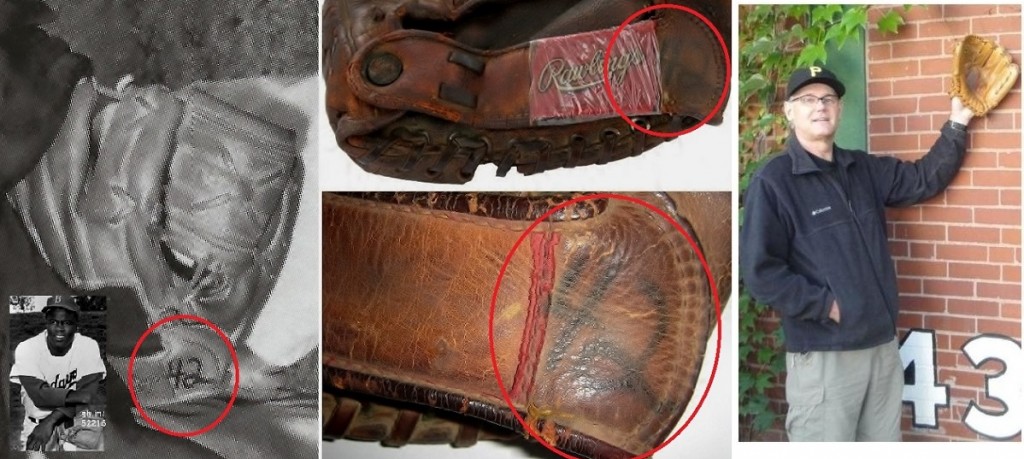
Denny Esken (right) made similar claims that a glove offered by Steiner Sports (center) was "photo-matched" as the last glove Robinson ever wore. But a photo from 1956 (left) reveals that Robinson wore different gloves as evidenced by the "42" he wrote on the strap (see red highlights).
It’s not the first time Esken has made a spectacular claim without supporting evidence as he did the same thing last year when he authenticated what he claimed was Jackie Robinson’s last glove from 1956 (and the glove he wore during the 1955 and 1956 World Series). Esken claimed to have “photo-matched” Robinson’s glove from an image taken during Spring Training in 1956, but that didn’t prove Robinson wore the glove in his last game or in the World Series and, as it turned out, the glove he authenticated was not a “photo-match.” It was a different glove.
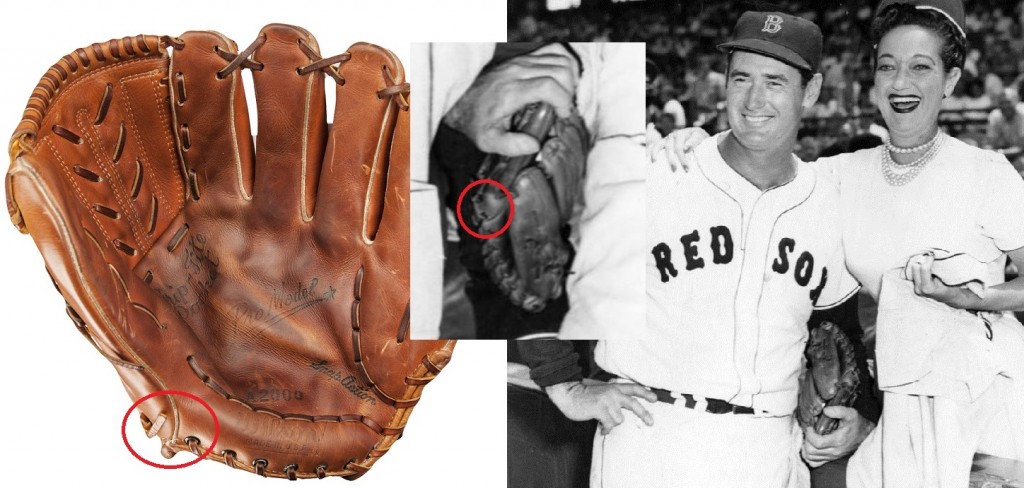
Despite PSA/DNA's claims that Williams' glove was a Wilson A-2000, this photo from July 4, 1960, shows Williams wearing another glove with a different heel construction. The glove depicted in the Boston Globe photo shows close to nine metal eyelits whereas the Goldin glove has only six.
In a report published in the summer of 2012, Hauls of Shame presented several photos of Jackie Robinson during the 1956 season and during spring training that clearly showed him wearing a glove different from the Esken authenticated glove that was offered by Steiner Sports. Despite Esken’s false claim, Steiner went on to sell the glove for over $373,000 without posting an addendum reflecting the misrepresentation of the glove to bidders.
As was the case with the Robinson glove, we also found a few photographs of Ted Williams wearing different gloves during the 1960 season. The first photo we encountered appeared in the Boston Globe from a Red Sox game played on July 4, 1960, and clearly illustrated Williams wearing a different model glove. The heel construction in the Globe photo showed at least nine different metal eyelets for lacing while the Goldin auction glove featured approximately six.

This AP photo from July 9, 1960, (top left) shows Williams wearing a different glove with a rectangular label contrasting with the oval Wilson logo alleged to have been Williams' last (bottom right). An undated Wilson A-2000 glove ad from Williams' personal scrapbooks c1959-60 (top right) shows his glove as different from the Goldin lot. Also pictured is a 1961 Wilson ad for the A-2000 (bottom left).
In addition, a second photograph we located was published by the Associated Press on July 9, 1960, and showed Williams posing with Roger Maris wearing a different glove which appeared to have been manufactured by Spalding. The glove was constructed with a rectangular label sewn onto the strap as opposed to the circular stitched “Wilson” logo which is visible on the strap of the Goldin glove.
In the Goldin lot description Esken offers additional information about the A-2000 Wilson glove itself stating:
“The Wilson 11 3/4″ “Shooting Star Palm” fielder’s glove shows the “344A” pro code under the wrist strap which confirms this glove was manufactured specifically for Williams himself. Made from premium Chicago leather, it boasts a Solid X-Lace Web, a new innovation at the time, making this style of glove closer to the modern version in use today than the ones available at the beginning of Williams’ career…”
Goldin and Eskin give the impression that the “344A” pro code was a specific designation for Williams, but others say it represents the code Wilson used for gloves made for MLB players in general.
In the past few decades only a few gloves have been sold as either “game used” or “attributed to” actual game use by Williams. Two of those gloves were sold by Heritage Auction Galleries in Dallas, Texas, and were accompanied by letters of opinion written by another recognized glove expert named Joe Phillips who operates an outfit called “The Glove Collector.” Philips noted that one of the gloves had a “3″ mark on the underside of the wrist strap and noted that a “344A” stamp was used on gloves that were considered “pro stock.” Based upon the characteristics of the gloves and two letters of provenance written by people who claimed to have received the gloves directly from Williams in the 1950’s, Philips wrote that the one glove was “very likely worn by Ted Williams during the mid-1950’s.” Heritage sold both gloves as “game used” and “game worn” by Williams. In 2004, when Heritage sold its first Williams glove, they noted that the only other known “game used” Williams gloves were one at the Baseball Hall of Fame and another with a “Boston area doctor who still holds it in his collection.”

Heritage has sold two other gloves said to be "game used" by Ted Williams (l to r) a c. 1955 glove given to a Williams friend and another from the 1950s attributed to Williams. A third glove resides at the Hall of Fame in Cooperstown. A Wilson ad from 1956 shows that Williams used Wilson products.
Before we actually interviewed auctioneer Ken Goldin and the experts at PSA/DNA it was rather easy to establish that Ted Williams wore a glove (or gloves) during the 1960 season that differed from the example being sold as his “last glove.” Reading John Updike’s New Yorker essay, it was even easier to establish the possibility that Williams was actually giving away multiple gloves in his possession in the weeks leading up to his last game at Fenway on September 28, 1960. In fact, it appears that Updike may have heard about Williams giving away his equipment in an article published in the Boston Herald on September 29, 1960 which reported, “Ted has been giving away bats and gloves the last few weeks, leaving little doubt but that he was sincere about his retirement that became official yesterday.”
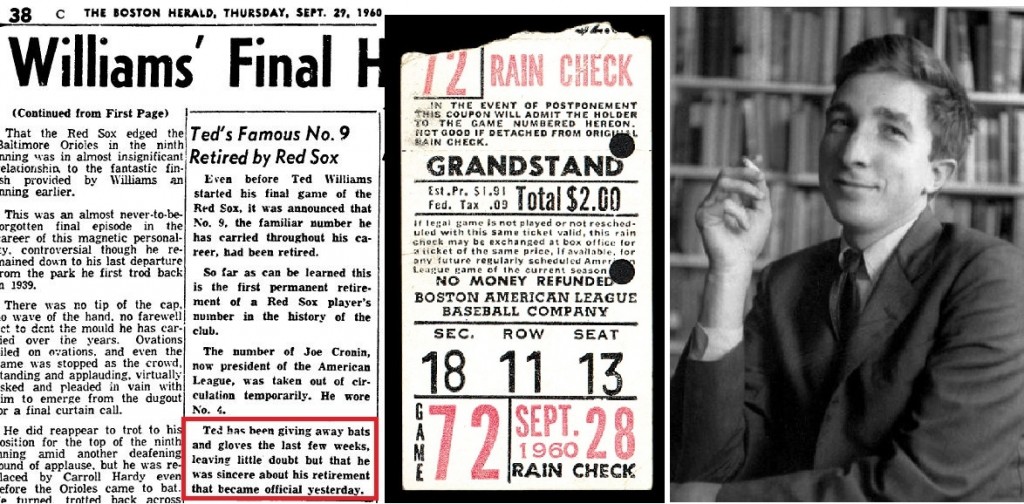
John Updike (right) likely read that Williams was giving away his bats and gloves in a Boston Herald article (right) published the day after his last game on September 28, 1960 (ticket, center).
So, what could Goldin or PSA/DNA provide that would somehow support their lofty claims and present the lot description as something that was supported by actual evidence? What could separate this alleged glove from other outright frauds that hobbyists have been deceived by recently like the “Shoeless” Joe Jackson “game used” bat offered for sale at Robert Edward Auctions with a fraudulent letter of opinion by PSA/DNA?
When I presented Ken Goldin with all of the information I had discovered, he proceeded to investigate the situation on his own and by Monday morning April 22nd he had posted a new PSA/DNA letter of opinion which described the glove as “One of the Last Gloves Used by Williams in the Major Leagues.” PSA experts John Taube and Dennis Esken were still claiming the glove was used by Williams during his last season, just not in his legendary last game as depicted in the actual auction catalog. The actual auction lot description was changed from Williams’ “very last glove” to “one of the very last gloves.”
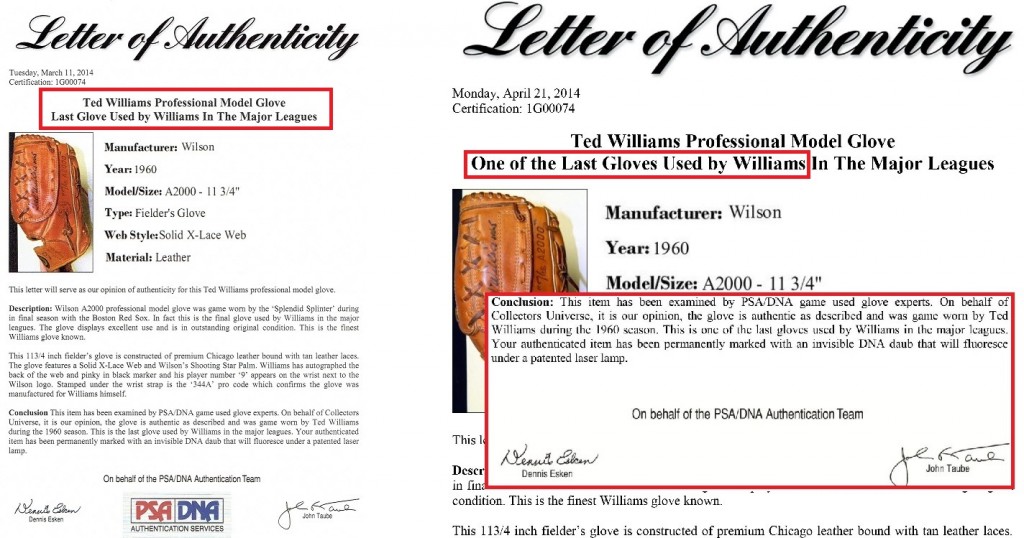
PSA/DNA replaced its original opinion of this glove's "game-use" in Ted Williams' last game to his "last season" based on information Hauls of Shame passed along to auctioneer Ken Goldin.
Based on the track record of the PSA experts Esken and Taube, however, was this downgrade of the letter of opinion from “game use” in Williams’ last game to just his “last season” credible?
According to the website VintageBaseball GloveForum.com, the Wilson A-2000 model glove featured a rectangular logo on the wrist strap up until at least 1963 and the round “W” logo appeared circa 1964, almost four years after Williams’ last game. If that information is correct, that would mean it was impossible for the Goldin glove to have been used by Williams in his last season or at any other time in his baseball career. It would mean that the opinion of “game use” rendered by Taube and Esken of PSA/DNA was entirely wrong. What type of research did PSA/DNA conduct to determine the glove was genuine?
The PSA website includes an online feature called “PSA Card Facts” which lets users view hi-resolution scans of every Topps baseball card ever issued since 1951, including Williams’ last season in 1960. The players posing for those cards sometimes wore their gloves and in some cases revealed the actual brand of glove they chose to use on the ball field. We decided to scan all of the cards issued from 1960 to 1967 to determine when the Wilson A-2000 glove (which was first introduced in 1957) changed its logo on the wrist from a rectangular shape saying “Wilson” to the oval “W” logo. The results of this review were quite remarkable.
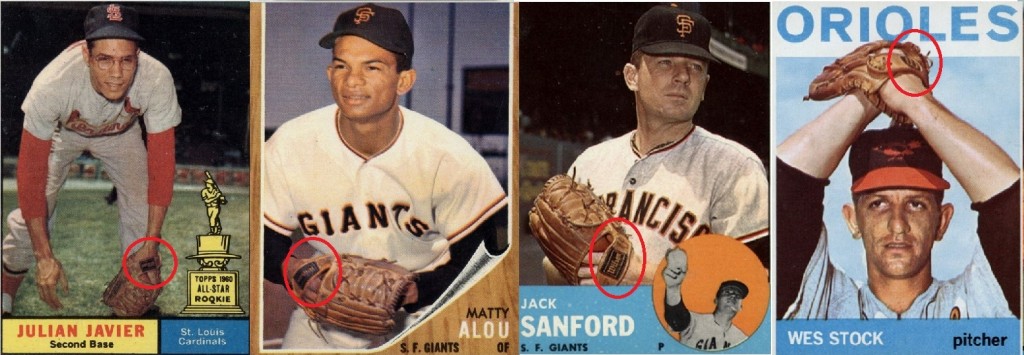
PSA Card Facts shows that in Topps cards issued from 1960 through 1964, the oval Wilson logo "W" doesn't appear until 1964 on the card of Wes Stock. All Wilson glove appearing on cards before 1964 have the rectangular "Wilson" logo affixed to the wrist strap.
According to the photographs used by Topps on its card products in the 1960’s, the first time a Wilson glove appears with an oval “W” logo is in 1964 on the baseball card of pitcher Wes Stock of the Baltimore Orioles. Topps would use photos of players taken in the previous season or during Spring Training of the year of issue, so the photo of Stock wearing the Wilson glove with the oval “W” logo could have been taken as early as 1963. If the Topps photos are an accurate representation of how Wilson introduced the new style of “W” logo into the Major Leagues, that would again make it impossible for the Goldin Williams glove to have been used in a game during the 1960 season. It isn’t until the seasons of 1965 and 1966 that the oval “W” logo appears with great frequency in the player photographs published by Topps.

The Topps cards of Red Sox pitcher Jack Lamabe illustrate best how Wilson introduced the oval "W" logo on its glove products. In his 1963 and 1964 cards he is wearing gloves with rectangular logos and in 1965 and 1966 the logo has changed to the oval "W" version.
Reviewing the Topps cards from this era on the PSA website also helped to establish the progression of Wilson products in reference to particular players, including Boston Red Sox pitcher Jack Lamabe. Lamabe is shown in his 1963 and 1964 cards wearing a Wilson glove with a rectangular logo on the strap while his cards from 1965 and 1966 show him wearing a Wilson A-2000 glove featuring the oval “W” logo just like the Williams glove up for auction. In addition, the Wilson product catalogs do not incorporate the oval “W” logo until the 1964 Spring issue and they continued through the 1960’s including the 1966 catalog which appears to include the exact same model A-2000 glove as the alleged Williams glove (“last game” & “last season”) authenticated by PSA/DNA.
Hauls of Shame spoke with PSA/DNA’s glove expert Dennis Esken to make some sense of the Williams glove controversy. When asked how he could justify writing an LOA saying the glove was from Williams last game Esken said, “I never said it was from his last game that wasn’t me. That’s a facsimile signature not mine. I said it was from his last season so that’s how it changed.” When asked who wrote the letter Esken said, “It was John Taube in his office and he really doesn’t know gloves like I do. They want me to look at the gloves coming to PSA because there are so many bad gloves people are trying to get by them,” said Esken. Esken also made a point to say he doesn’t work for PSA for the money but, rather, “to help the FBI” and weed out the bad gloves. Taube did not respond to our inquiry for comment on his PSA/DNA letter.

The Ted Williams glove alleged to be from his last season in 1960 is identical to a Wilson A-2000 model that appears in the 1966 Wilson catalog (left).
When asked what evidence he had that the Williams glove with the oval “W” logo was from 1960 (when it appears that such a glove first appeared in the Major Leagues in 1963), Esken said, “It was a prototype glove made for Ted. Twenty years ago I spoke to the Wilson guy who made the glove and he told me it was (made) for him.” In an email to Goldin Esken added, “There is a special number stamped under the wrist strap (344A). I was told by these designers that there was a number stamped to verify whose glove it was. That number matched their records for Ted Williams 1960!”
When we asked Esken if those numbers were simply codes for “pro model” gloves he replied, “These glove guys just don’t understand. Joe Phillips is emailing Goldin and saying the glove could only be from 1963 but he’s wrong, its a prototype.” Phillips did not respond to an email request for comment. Esken said he spoke to the Wilson designer over twenty years ago and said his name was Ted Javor. Esken said he was referred to Javor by another Wilson employee named Earl Malone who has operated a glove repair business in his post-Wilson days. Hauls of Shame attempted to contact Malone for comment but was unsuccessful. When we asked Esken where the Wilson documentation for the “344A” code was now and if he could provide contact information for Ted Javor he replied, “No, that was a long time ago, he’s probably dead by now.”
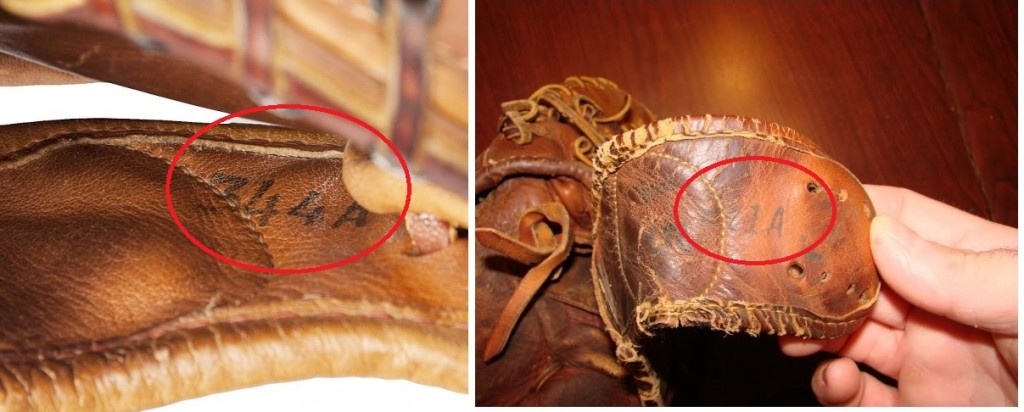
The Goldin Williams A-2000 glove has "344A" stamped on the inside wrist strap (left). Another A-2000 displayed on a collector website has a "241A" stamp.
If Esken’s claim that the Williams glove was a prototype were true, it would mean that a glove that appeared in the 1966 Wilson catalog was given to Ted Williams six years earlier. We asked Esken why there is no photographic evidence showing players wearing Wilson gloves with the oval “W” logo before 1963 and he said, “It was just for Ted, only he had it.”
Esken also revealed that the consignor and owner of the glove was Dr. David L. Pressman of Chelsea, Massachusetts, and when asked how he could know which glove Pressman had considering reports of Williams giving glves away Esken said, “I know he was giving away his gloves and Dr. Pressman knew Ted and wanted his last glove and he got it. Donovan got the glove for him from Ted. Donovan hardly had the glove, the Doctor has had it for like 54 years. I found out about the glove from the Doctor over twenty years ago when I checked it out.” Esken added that Pressman couldn’t go to Fenway Park to get the glove that day because he had class in medical school at Harvard and sent Donovan to get that particular glove because it was “the nice one” he wanted as opposed to another glove that he said wasn’t in good shape.
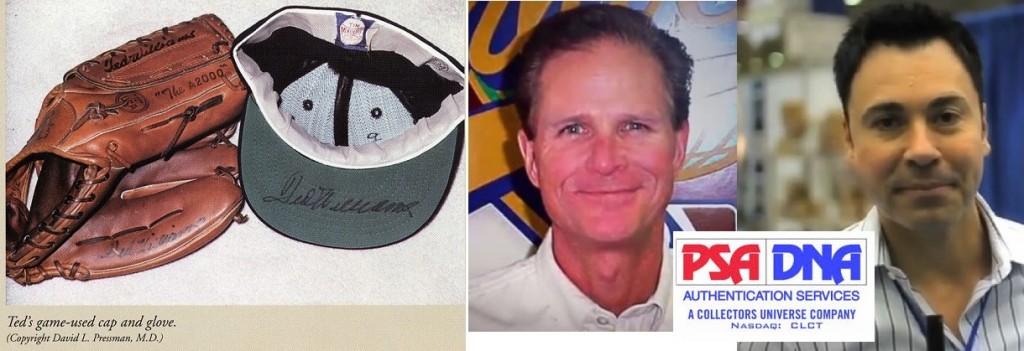
Dr. Pressman's Williams glove appeared in a bok written by Bill Nowlin and Jim prime as a "game used" glove with no mention of "last game" or "last season." PSA/DNA authenticator John Taube (center) issued a letter alleging it was from his last game. The company headed by Joe Orlando (right) has since issued a replacement letter alleging game use in 1960.
Esken’s hearsay account contradicted Goldin’s description of John Donovan’s acquisition of the glove and, as a result, Goldin told us, “We rely on the consignor as well as the authenticator in instances like the Ted Williams glove where it is not part of an MLB authentication or similar program. Our consignor was a longtime friend of Ted Williams (a point that is without dispute) and has written to us confirming that he received the glove from Donovan on behalf of Ted Williams and was told it was a game used glove from his final season (1960).” Pressman, however, did not provide for Goldin any of the details Esken described.
Pressman has been quoted in several articles written about Williams after his death and his glove was featured as just a “game-used” glove in a 2002 book written by Bill Nowlin and Jim Prime called, Ted Williams: The Pursuit of Perfection. In 2001, Pressman was also critical of Williams’ son and told the LA Times, “John Henry needs a good Irish kick in the (rear). He’s not what you’d expect from Ted Williams whose word was golden.”
In regard to the glove, Esken’s claims boil down to his own credibility. If you examine Esken’s claim that the current glove in the Goldin auction was a prototype issued to Willliams three to six years before it began appearing on the field with MLB players, you must confront the actual hard evidence that exists in the form of actual photographs of Williams wearing what are clearly two different gloves on July 4th and July 9th, 1960. In addition, you must also confront the existence of the c.1960 Wilson advertisement which shows Williams holding an A-2000 glove with a rectangular logo patch.
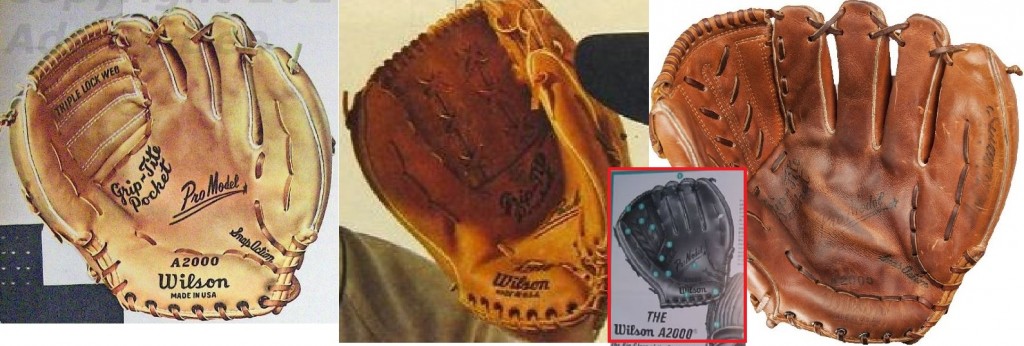
Wilson A-2000 gloves appeared in catalogs and print ads but were used by some players beforehand. The A-2000 also incorporated several different design elements between 1961 (left) 1964 (center) and 1966 (inset catalog picture). The Goldin Williams glove matches the A-2000 in the 1966 Wilson catalog exactly in construction and graphics.
Esken also can’t explain why the alleged “protoptype” glove matches exactly the Wilson A-2000 glove that appears illustrated in the 1966 Wilson catalog. It has been demonstrated that there is a lag-time involved between the time gloves are designed and constructed and when they actually appear in catalogs and print ads. Those gloves also can get into the hands of MLB players well before they are made public and in some cases it has been shown that certain designs could be “game used” even a year before the glove has been made an official model. But the A-2000 model incorporated a host of contrasting design elements from year to year during the time period between 1960 and 1966.
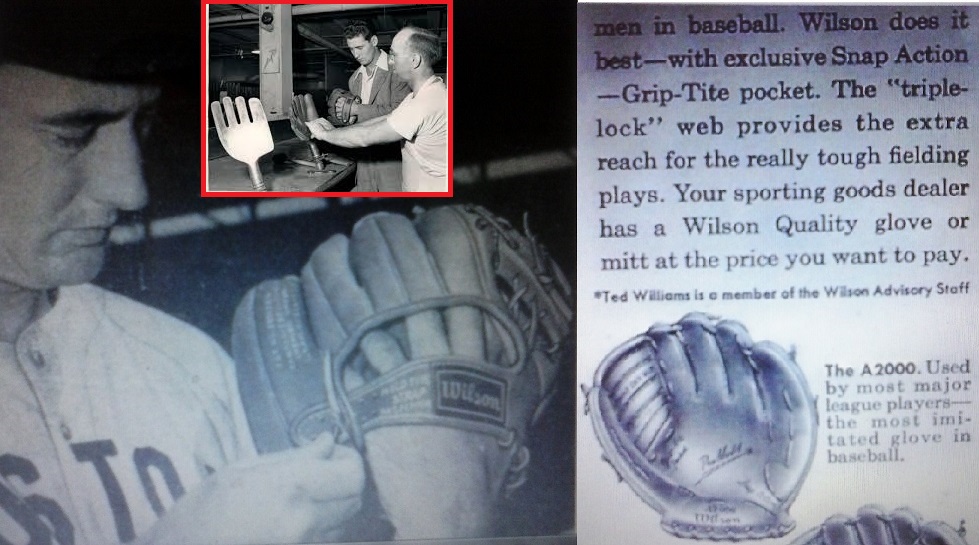
Ted Williams was a member of Wilson's advisory board and had visited the Wilson glove factory early in his career (inset). In 1956 (the season before the A-2000 was introduced), Williams appeared in an ad wearing another Wilson glove model. In another 1959 ad (right) an illustration of the A-2000 was revealed.
Would an alleged prototype glove be more likely to resemble gloves that are a year or two removed from a catalog appearance or six years like the alleged Williams glove? And what would be the odds that the Williams glove would match the 1966 glove exactly if they really were separated by six years of designs and improvements? Did it actually take six years for that design to enter the market? Then consider that all of the visual evidence flies in the face of Esken’s claims that the Williams glove was a prototype sent only to him. Based on the story that the glove came directly from Williams, the evidence suggests that this glove was more likely used by him as an instructor, coach or manager after his playing days.
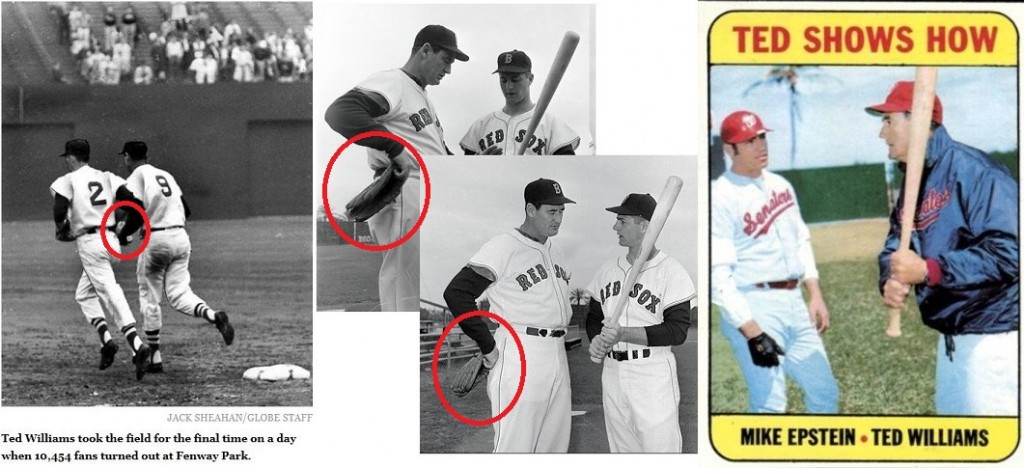
The Boston Globe published a photo of Williams wearing his last glove on the field during his last game (left). Williams continued with the Red Sox as an instructor in 1961 (center) and used other gloves when he instructed players in his role as a coach and as a manager with the Washington Senators (right).
Auctioneer Ken Goldin relies on the authentication companies for opinions and assumes that the companies are competent enough to consider these issues. Goldin responded to our inquiries and stated, “The authenticator, PSA/DNA, not only provided an LOA on the glove, but at my request provided additional information to me, in writing, regarding the glove.” As for the confusion about how and when the glove was acquired by Pressman, Goldin added, “To ensure there is no confusion as to the chain of custody on the glove, we edited out (the) description regarding that.”
Dr. Pressman could not be reached for comment and neither Esken or Goldin were willing to provide his contact information. Goldin did, however, provide us with a statement Pressman prepared on Friday for the auction house in which he mentions his inclusion in Ben Bradlee Jr’s recent Williams biography, The Kid, and says, “I first met Ted Williams in 1948 and had a close personal relationship with him most of his life.” Of the acquisition of the glove Pressman says, “Ted Williams gave John Donovan his game used glove from the 1960 season with instructions to get it to my family. I retrieved the glove from John. I was told by John and Ted it was his game used glove from his final season. It has been in my family’s possession since we received it.”
Pressman, however, did not indicate exactly when he acquired the glove in his statement and when we asked Ken Goldin whether Pressman could address what the date or even the year was he replied, “He only wrote what he 100% remembered from over 50 years ago. No speculation or “I think(s).” He didn’t remember the exact date so he did not include it. I got the impression it was shortly after.”
The date issue is also notable because Pressman wasn’t even living in Boston at the time Williams retired. He was attending medical school at Columbia University in New York City from 1958 through 1961. Considering his claims of having a close relationship with Willaims and Esken’s story that he was able to choose which glove he wanted as a gift, it would appear that this would be more difficult to do while living in Manhattan in 1960.
Esken says that Pressman sought him out to show him the glove about twenty years ago. Of Pressman’s glove Esken told us, “That glove was his baby. He once offered it to me for $200,000 based on what that Mantle glove sold to Billy Crystal for. I thought it was too much.”
The glove sold on Friday night for $88,157. Someone out there thought it was at least worth that, but can the winning bidder ever really know for sure it was used by Ted Williams in 1960?
